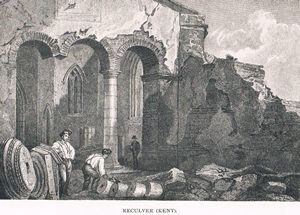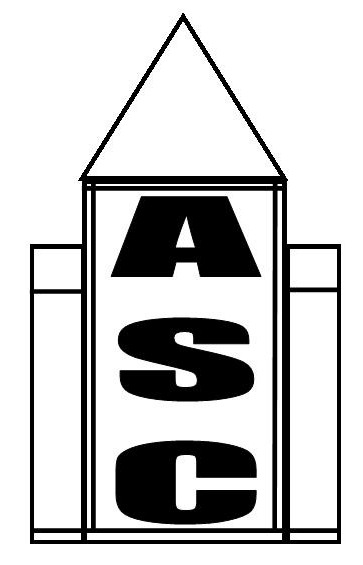
We remember the reforming archbishop, the Syrian, Theodore of Tarsus, Archbishop of Canterbury (669-90).
Flanking porticus.
The churches at Reculver and Bradwell-on-Sea had differing porticus from other churches of the group. They partly flanked the chancel, and this feature is not to be found elsewhere in western Europe at this date. Significantly, both churches are about fifty years later than the main Kentish group, and in those fifty years Syrian civilisation had collapsed with the arrival of the Persians in 610. The outcome was the dispersal of Syrian monks and craftsmen throughout Christendom, and it is to them that the unusual arrangement of the porticus at Bradwell and Reculver can be ascribed. Curiously the plan (dated 1840) of Lady St Mary, Wareham, Dorset, shows exactly the same arrangement of the now demolished part of the Anglo-Saxon church. These flanking porticus are not in fact for burials but are the diaconicon and prothesis of the Syrian church – chapels used for the receipt of offerings from the faithful and their preparation for the altar.(i)
Reculver is an ancient foundation, the Anglo-Saxon Chronicle relates that in the year 669 King Egbert of Kent gave Reculver to Bassa the priest to build a minster there. Previously King Hlothere of Kent gave land on Thanet and at Sturry to Abbot Berhtwald and his minster of Reculver, in a charter of 679, the oldest to survive as an original, and said to be issued ‘in the city of Reculver’ (in civitate Reculf), which was by this date an ecclesiastical civitas within the walls of the Roman fort.
The minster church of Reculver exhibits the kind of features that we do not find in work in a later period. The chancel arch, an arcade of three round arches supported by 2 pillars, their shafts of nine cylindrical stones are tapered, and the effect, when one looks at the plate (right) of the east wall of the nave and chancel arch, is very reminiscent of a Roman temple, and it is highly probable that the builders reused Roman columns obtained from a nearby building. These columns thankfully survive having been moved and may be viewed in the crypt at Canterbury cathedral. The church at Reculver does not exhibit Saxon pilaster strips but it does have ‘Kentish’ buttresses which protrude some 2 feet. This is a Syrian feature since the church was built to Syrian ritual and practise by Syrian craftsmen, as the flanking porticus shows.
click here to go to the 'British History Online' site on Reculver (exits this site).
List of triple chancel arches.
Reculver (not in situ)
St Pancras, Canterbury (ruins)*
Bradwell-on-Sea*
* traces only remain, in situ.
(i) source: Anglo-Saxon England by Lloyd & Jennifer Laing. ISBN 0 7100 01134
For more information on the present day site at Reculver click here.
St Augustine & Early Churches. Canterbury.
Canterbury, Abbey of St. Augustine
Click here for main menu (including photo pages of individual selected churches).
Over 400 Saxon churches listed! - an invaluable listing, a downloadable table (unique to this site) which gives information of the known churches in England exhibiting Saxon features and fabric (and with details of those features), a comprehensive listing noted by place name, county, and grid reference; wholly based on H.Taylor's three sterling volumes, "Anglo-Saxon Architecture".
Searching for a particular church? See if its featured here.
plate above right: Reculver church and the triple chancel arch, during demolition in the 19th century.
www.anglo-saxon-churches.co.uk
